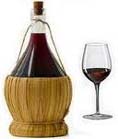Frequently Asked Questions 2
from Italian Traditional Food

Frequently asked questions ( FAQ ) page 2
for Italian Traditional Food
Welcome to the Italian Traditional Food frequently asked questions page 2. Listed below is a selection of
frequently asked questions raised by site visitors. Click on any question of interest
in order to obtain the answer. Also visit the Articles, Articles 2, Articles 3, Articles
4, Articles 5, Articles 6, Articles 7, Cookbooks, Cookbooks
2, Cookbooks 3, Glossary, Glossary 2, Glossary 3, Glossary A-E, Glossary F-N, Glossary O-Z, Links, Italian Pantry Ingredients, About Me, FAQ, FAQ 3, Oven Temperatures, Measurement
Converter, Cooking Tips, and Recipes
pages.
<< Previous Page 2 Next
>>
Frequently Asked Questions:
-
Q: Why does my electric mixer make my egg whites soft and
runny?
-
A: Make sure that your bowl and beaters are dry. Any trace of
water will stop the egg whites from whisking into peaks. Otherwise, I would use your electric
mixer for starting off your meringues and taking the hard work out of whisking, but when the
egg whites just reach the foamy stage, finish off by hand, using a balloon whisk.
return to top
-
Q: How can you prevent cooked rice
from sticking while it is drying?
-
A: Firstly, take care not to overcook the rice -12 minutes is the
correct time for boiling it. When cooked, rinse it well with hot water, and drain well in a
colander. Then tip it into a large, flat well-buttered dish and put it to dry in a moderate
oven (175C or Gas Mark 4) for 30 minutes, turning with a fork from time to time.
return to top
-
Q: Is there a simple way of converting oven
temperatures?
-
A: Here is a print of an oven temperature Conversion table that I
found in an old cookery book. I refer to it all the time because it is so easy to
understand.
return to top
-
Q: Why does the crust leave the loaf
when I bake bread?
-
A: The reason why the crust leaves the loaf is because the
mixture has been over-risen, and the texture has become too open.
return to top
-
Q: Why can't I get my yoghourt to
set?
-
A: The reason why you are not getting a proper "set", is because
you are bringing the milk almost to boiling point instead of heating it to just over blood heat
before adding your culture. The making of yoghourt calls for constant, gentle heat - boiling
will ruin it.
return to top
-
Q: Which flour should I use in a
recipe?
-
A: Some recipes stipulate the use of plain flour, others state
self-raising flour and in some it just states "flour". If a recipe requires self-raising flour
then it should stipulate it. If the word "flour" is used then it usually refers to plain flour.
Hope that this has clarified the situation for you.
return to top
-
Q: Why can't I whip double cream to
the thickness for piping?
-
A: When piping double cream make sure the cream is at
refrigerator temperature; if left in a warm kitchen for only a short time, it's difficult to
whip. You can always stand the bowl of cream in a larger one containing water and some ice
cubes. Then beat the cream until it thickens.
return to top
-
Q: What is the difference between
Gruyere and Emmenthal cheese?
-
A: A simple way to tell them apart is that Swiss Emmenthal has
large holes and Swiss Gruyere has very small holes. The flavour is very similar, but Gruyere is
more piquant.
return to top
-
Q: Is there a suitable substitute
for gelatine as I am a vegetarian?
-
A: There is a setting agent called agar-agar which is made from
seaweed and can be used in place of gelatine.
return to top
<< Previous Page 2 Next
>>
| 


 Digg
Digg Stumbleupon
Stumbleupon Google Bookmarks
Google Bookmarks Delicious
Delicious Twitter
Twitter Facebook
Facebook Yahoo My Web
Yahoo My Web Reddit
Reddit